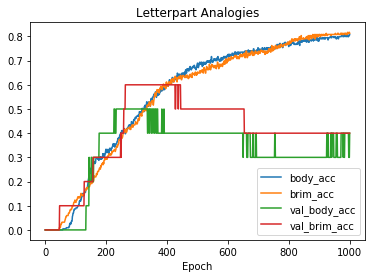3.16. Gridfonts¶
This notebook explores the datasets “gridfonts” and “figure-ground-a” based on Douglas Hofstadter and colleagues Letter Spririt project. See also gridfonts.
This data was used in both Gary McGraw’s and Douglas Blank’s theses to train neural networks. See section 6.3.2 of McGraw’s thesis, and Blank’s thesis Learning to See Analogies: a Connectionist Exploration.
figure-ground-ais composed of letter a’sgridfontis composed of entire alphabets
In [1]:
import conx as cx
Using Theano backend.
Conx, version 3.6.0
3.16.1. Letterpart Analogies¶
First, we download and load the figure_ground_a dataset:
In [2]:
ds = cx.Dataset.get("figure_ground_a")
In [3]:
ds.summary()
Dataset name: Figure-Ground A
This dataset (the so-called a-tabase) originates from Douglas Hofstadter’s research group:
http://goosie.cogsci.indiana.edu/pub/gridfonts.data

Gridfont Grid
These data (all the letter A) have been processed to make them neural network friendly:
https://github.com/Calysto/conx/blob/master/data/gridfonts.py
The brim and body parts have been idenified manually. The dataset is composed of letters on a 17 row x 9 column grid (4 lines not used on top and another 4 not used on the bottom of each letter were removed from the original 25x9 latter images). The inputs are composed of the full letter. The targets are composed of a picture of the body and the brim.
You can read a thesis using part of this dataset here: https://repository.brynmawr.edu/compsci_pubs/78/
Dataset Split: * training : 229 * testing : 0 * total : 229
Input Summary: * shape : (153,) * range : (0, 1)
Target Summary: * shape : [(153,), (153,)] * range : [(0, 1), (0, 1)]
The figure_ground_a database is composed of 229 a’s where:
- input - a 153 integer “picture” of an “a” representing 17 rows and 9 columns
- targets - two 153 pictures, representing the “brim” of the letter a, and the “body”
Let’s display the letters in a graphical manner:
In [4]:
def display_letter_parts(letter, brim, body):
print("Letter Brim Body")
for row in range(17):
for col in range(9):
print("." if letter[row * 9 + col] == 0 else "X", end="")
print(" ", end="")
for col in range(9):
print("." if brim[row * 9 + col] == 0 else "X", end="")
print(" ", end="")
for col in range(9):
print("." if body[row * 9 + col] == 0 else "X", end="")
print()
In [5]:
display_letter_parts(ds.inputs[0], ds.targets[0][0], ds.targets[0][1])
Letter Brim Body
......... ......... .........
......... ......... .........
......... ......... .........
......... ......... .........
....XXXXX ....X.... ....XXXXX
...XX...X ...X..... ....X...X
..X.X...X ..X...... ....X...X
.X..X...X .X....... ....X...X
X...X...X X........ ....X...X
...X...X. ......... ...X...X.
..X...X.. ......... ..X...X..
.X...X... ......... .X...X...
XXXXX.... ......... XXXXX....
......... ......... .........
......... ......... .........
......... ......... .........
......... ......... .........
Let’s design some networks that attempt to replicate the brim and body given the original gridfont letter.
First, let’s change the format of the dataset input so that we can treat the input as a 2D 17 x 9 image rather than merely a vector of 153 values. We actually make it a 3D shape, the third dimension representing color (which it doesn’t have).
In [6]:
ds.inputs.reshape(0, (17, 9, 1))
In [7]:
cx.shape(ds.inputs[0])
Out[7]:
(17, 9, 1)
In [8]:
cx.array_to_image(ds.inputs[0], scale=10)
Out[8]:

In [9]:
cx.array_to_image(ds.targets[0][0], scale=10, shape=(17,9))
Out[9]:

In [10]:
cx.array_to_image(ds.targets[0][1], scale=10, shape=(17,9))
Out[10]:

We can now use a Convolutional Layer to better process the letter “picture”. Notice that we flatten the output of the Convolutional layer to bring the output back into a single dimension.
In [11]:
net = cx.Network("Letterpart Analogies")
net.add(cx.Layer("input", (17, 9, 1)))
net.add(cx.Conv2DLayer("conv", 2, (2,2)))
net.add(cx.FlattenLayer("flatten"))
net.add(cx.Layer("hidden", 50, activation="relu"))
net.add(cx.Layer("brim", 153, vshape=(17, 9), activation="sigmoid"))
net.add(cx.Layer("body", 153, vshape=(17, 9), activation="sigmoid"))
net.connect("input", "conv")
net.connect("conv", "flatten")
net.connect("flatten", "hidden")
net.connect("hidden", "brim")
net.connect("hidden", "body")
net.compile(error="mse", optimizer="adam")
We associate the dataset to the network, and save 10 pictures for testing.
In [12]:
net.set_dataset(ds)
net.dataset.split(10)
In [13]:
net.dashboard()
Now, we are ready to train the network to replicate the letter parts.
In [14]:
net.train(1000, accuracy=1.0, tolerance=0.4, batch_size=128, report_rate=100)
========================================================
| Training | Validate | body | brim | val | val
Epochs | Error | Error | acc | acc | body acc | brim acc
------ | --------- | --------- | --------- | --------- | --------- | ---------
# 1000 | 0.00643 | 0.04467 | 0.80822 | 0.81279 | 0.40000 | 0.40000
In [15]:
net.plot(".*acc")

In [16]:
net.picture()
Out[16]:
In [17]:
results = net.train_one(ds.inputs[8], ds.targets[1])
3.16.2. Gridfonts - leter recognition¶
In [18]:
ds = cx.Dataset.get("gridfonts")
In [19]:
ds.summary()
Dataset name: Gridfonts
This dataset originates from Douglas Hofstadter’s research group:
http://goosie.cogsci.indiana.edu/pub/gridfonts.data

Gridfont Grid
These data have been processed to make them neural network friendly:
https://github.com/Calysto/conx/blob/master/data/gridfonts.py
The dataset is composed of letters on a 25 row x 9 column grid. The inputs and targets are identical, and the labels contain a string identifying the letter.
You can read a thesis using part of this dataset here: https://repository.brynmawr.edu/compsci_pubs/78/
Dataset Split: * training : 7462 * testing : 0 * total : 7462
Input Summary: * shape : (25, 9) * range : (0.0, 1.0)
Target Summary: * shape : (25, 9) * range : (0.0, 1.0)
In [20]:
net = cx.Network("Gridfonts")
net.add(cx.Layer("inputs", (25,9)))
net.add(cx.FlattenLayer("flatten"))
net.add(cx.Layer("hiddens", 20, activation="sigmoid"))
net.add(cx.Layer("outputs", (25, 9), activation="relu"))
net.connect()
net.compile(error="mse", optimizer="adam")
In [21]:
net.set_dataset(ds)
WARNING: network 'Gridfonts' target bank #0 has a multi-dimensional shape, which is not allowed
In [22]:
display(net)
output = net.propagate(ds.inputs[26])
print(ds.labels[26])
a
In [23]:
def display_letter(letter):
print("Letter")
for row in range(25):
for col in range(9):
print("." if letter[row][col] == 0 else "X", end="")
print()
In [24]:
display_letter(ds.inputs[0])
Letter
.........
.........
.........
.........
.........
.........
.........
.........
....XXXXX
...XX...X
..X.X...X
.X..X...X
X...X...X
...X...X.
..X...X..
.X...X...
XXXXX....
.........
.........
.........
.........
.........
.........
.........
.........
In [25]:
cx.array_to_image(ds.inputs[0], scale=10)
Out[25]:

In [26]:
cx.array_to_image(ds.targets[0], scale=10)
Out[26]:
